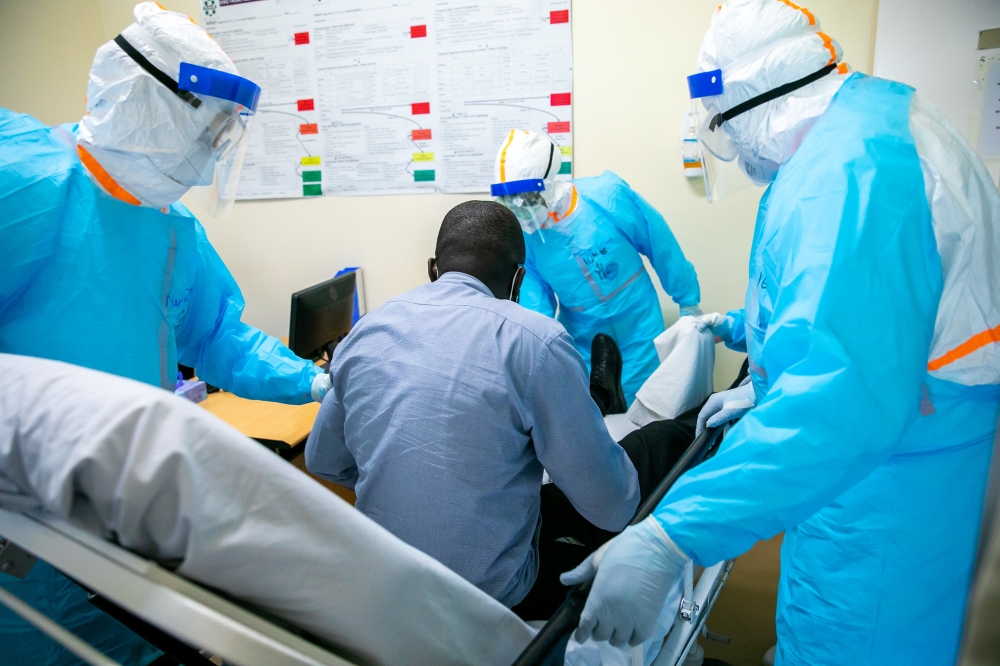

October 17 marked exactly twenty days since Rwanda declared the Marburg virus outbreak on September 27.
The virus was confirmed in patients who had shown malaria-like symptoms and were treated for the disease but their condition deteriorated.
Symptoms of the virus are high fever, severe headaches, muscle ache, fatigue, vomiting and diarrhoea.
When the first patients’ condition continued to deteriorate, the Rwanda Biomedical Centre (RBC) and the National Reference Laboratory were prompted to intervene for further examination.
ALSO READ: How Rwanda detected the first Marburg virus cases
Blood samples were taken and tested using real-time reverse transcription polymerase chain reaction (RT-PCR) and the results confirmed the presence of the Marburg virus.
The New Times looks at what is known – from confirmed cases, fatalities, recoveries, vaccination, among other things – since the day Rwanda confirmed its first ever Marburg virus outbreak.
Cases
As of October 17, a total of 62 cases of the haemorrhagic disease had been confirmed.
According to the Ministry of Health, all confirmed cases since the outbreak announcement have been within a hospital cluster in Kigali and their contacts, with all individuals currently under isolation and treatment.
On October 3, Minister of Health Dr Sabin Nsanzimana said that healthcare workers comprise over 80 percent of the confirmed cases of Marburg virus disease.
The minister also said that there was no evidence of community transmission.
Deaths
Since the outbreak was declared, there have been 15 confirmed deaths.
The Marburg fatality rates range between 24 and 88 per cent, according to the World Health Organisation (WHO).
While previous Marburg virus outbreaks typically had case fatality rates sometimes exceeding 80 per cent, Rwanda’s current outbreak has shown a fatality rate of 24 per cent.
ALSO READ: Why Rwanda's Marburg fatality rate is lower than in previous outbreaks
Dr. Nsanzimana attributed this lower rate to early detection of cases and the availability of multiple therapeutic options.
He said that the efforts to contain the outbreak are giving positive results with the number of deaths from the Marburg virus lower than that of recoveries.
Recoveries
To date, 43 individuals have recovered from the disease.
"Recoveries now outnumber deaths, which is a positive indication that our efforts are making an impact,” Dr. Nsanzimana noted.
To be considered recovered, patients must test negative twice, with tests spaced 72 hours apart.
Testing
As of October 17, a total of 4,486 tests have been conducted, with 271 new tests performed.
Treatment
Rwanda has used two treatment options for Marburg virus: the antiviral drug remdesivir, which has also been used for COVID-19, and monoclonal antibodies specifically developed to combat the Marburg virus disease.
Dr. Nsanzimana confirmed that these treatments have shown positive results in Marburg virus patients.
Additionally, Rwanda, in partnership with the WHO, is testing the safety and efficacy of remdesivir in Marburg patients.
Currently, four individuals are in isolation and receiving treatment.
ALSO READ: Rwanda begins world's first clinical trial for Marburg virus disease treatment
Vaccination
In response to the outbreak, the Sabin Vaccine Institute, an American non-profit organsation, delivered a total of 1,700 vaccines.
The first shipment of 700 vaccines arrived on October 5, followed by an additional 1,000 doses eight days later.
The trial vaccination program primarily targets healthcare workers and those at high risk, particularly staff in intensive care units (ICUs) who face greater exposure to the virus.
As of October 17, 876 vaccine doses had been administered.
The Ministry of Health assures that the Marburg virus vaccine has undergone all necessary testing phases, including laboratory studies, animal trials, and human trials.
It has been used in humans since 2018, showing positive data on its safety, tolerability, and immune response.
The vaccine has also been successfully tested in Uganda, Kenya, and the United States.
Preventive measures
To control the outbreak, the Ministry of Health stresses the importance of community engagement.
Public education about the nature of Marburg virus disease and outbreak containment measures is crucial.
Preventing human-to-human transmission by avoiding direct contact with infected individuals and their bodily fluids, while healthcare workers adhere to strict infection control protocols.
Ensuring that burial ceremonies are conducted safely and respectfully to prevent transmission from deceased individuals.
Maintaining high hygiene standards, such as regular handwashing, particularly after visiting sick relatives or caring for infected individuals.
To prevent transmission, the ministry suspended hospital visits and school visits.


